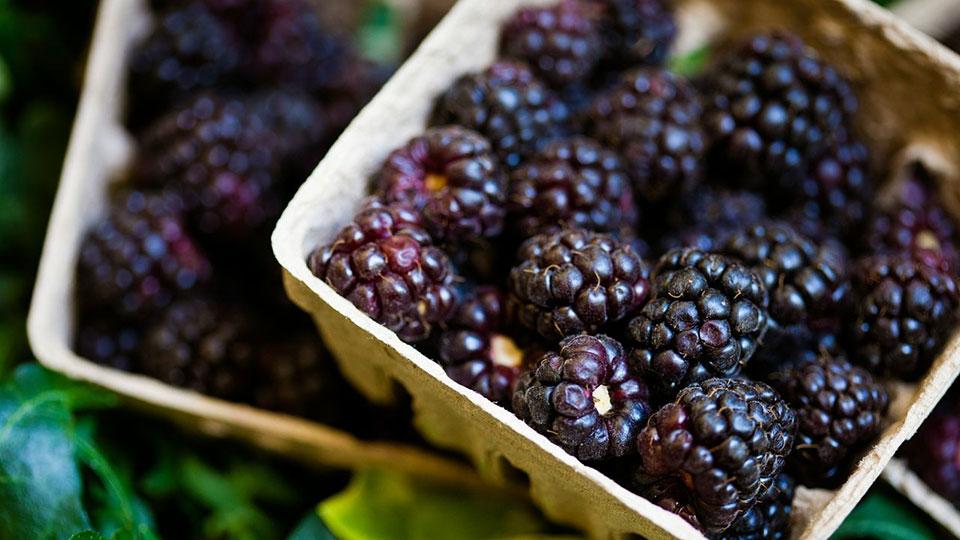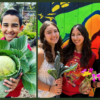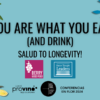Over the past seven years, the annual Berry Good Night dinner has aimed to connect and celebrate local and sustainable farmers, ranchers, fishermen, chefs, and vintners.
In September 2017 we debuted a new format (#BGN100) to increase interaction and engagement. After submitting responses to a brief questionnaire, 100 “idea ambassadors” were hand selected for their commitment toward fundamental change in our food system.
Over the course of 2018, we are profiling the participants to highlight their efforts and create greater awareness and connection within our community.
This month we focus on sustainable seafood and speak with the following purveyors, chefs, scientists, educators and advocates:
- Dave Rudie, a seafood wholesaler and advocate of local, sustainable seafood
- Andrew Spurgin, chef consultant and co-founder of Passionfish, a public sustainable seafood education project
- Dimitri Deheyn, a marine biochemist and ecotoxicologist
- Amro Hamdoun, a marine environmental toxicologist and physiologist
Dave Rudie, Catalina Offshore Products
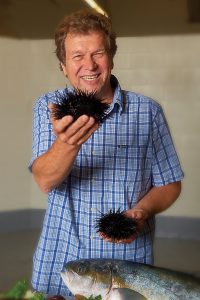
Dave Rudie
Please tell us briefly about your work and your goals.
I am the founder of Catalina Offshore Products, which is one of the largest buyers of local seafood in San Diego. We specialize in wild species found off the West Coast, from Baja California to the Pacific Northwest, and operate a wholesale division, restaurant program, walk-in fish market and online store. We buy nearly half of all the seafood landed locally. My goal is to keep as much of that as possible in San Diego.
Did you make any interesting connections at BGN100?
Yes, and I met Scott Peters, my congressman.
Are there other ways you have successfully connected with like-minded members of the community to further your mission?
I contribute expertise to numerous initiatives. In addition to serving on San Diego Food System Alliance’s Seafood Working Group, I am the CEO of the California Fisheries and Seafood Institute; President of the California Pelagic Fisheries Association; Chairman of the Pacific Fishery Management Council‘s Highly Migratory Species Advisory Subpanel; Policy Co-Chair of The Maritime Alliance; and a longstanding voice on the California Sea Urchin Commission. I am engaged in several political efforts in support of our local fisheries and work closely with NOAA Fisheries and Scripps Institution of Oceanography on behalf the seafood industry. My involvements with local fishermen, scientists, and both government and non-government organizations have resulted in funding for various conservation efforts, including Marine Protected Areas (MPA) monitoring and collaborative fisheries research. I have also been involved in some of the longest term (20+ years) independent fishery research for sea urchin.
When you’re not working, what do you enjoy doing?
Diving, underwater photography and gardening.
Do you have a favorite seafood story or recipe you’d like to share?
This is my recipe for homemade tune poke, I also like to make this with escolar and serve over black sticky rice for contrast.
Tuna Poke:
- Cut 1lb tuna (local bigeye or yellowfin) into small pieces
- Add about a half teaspoon of sesame oil then sprinkle in some sesame seeds, salt, pepper and chopped green onions to taste
- Mix and chill
- Add soy sauce just before eating (you can keep the poke longer this way)
- Serve over prepared sushi rice.
Andrew Spurgin, Passionfish and andrewspurgin.com
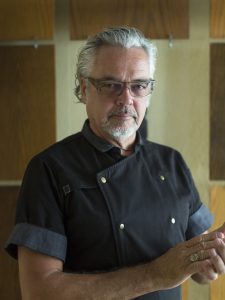
Andrew Spurgin (photo credit: Robert Benson)
Please tell us briefly about your work and your goals.
My work as a chef consultant and event architect, design and catering consultant (I’m a one-man show) is comprised of a myriad of different jobs. I consult to the industry, meaning I create recipes and menus, train restaurant kitchen and catering staff, and create and design events from soup-to-nuts. I have been blessed to do that here in the States, in Japan and in the UK. One of our most inspired projects is our “Culinary Time Travel™” events, where we recreate menus and cater fabulous events from the past.
As far as goals, aside from continuing to promote sustainable seafood education with Passionfish, which I co-founded and have been engaged in for the last 20 years, I’m considering an illustrated cookbook. This would feature sketches that I pen for the recipes and plates and would naturally include a few tall stories to boot!
Did you make any interesting connections at BGN100?
I most certainly had some sound conversations with a number of people that evening! Many of the “connections” there I knew previously and appreciated hearing what they were up to these days!
Are there other ways you have successfully connected with like-minded members of the community to further your mission?
Birds of a feather tend to flock together, and as such I spend a lot of time with folks in the food industry – chefs, restaurateurs, purveyors and the like, most of whom are highly motivated, passionate and are doing great work. It’s inspiring to surround one’s self with people like that, it keeps you on your toes!
When you’re not working, what do you enjoy doing?
I spend a lot of time in Tijuana, the Valle de Guadalupe and Ensenada, I simply love all that is going on down there. The people are just amazing, I love their zest for life, unselfishness, incredible passion and generosity. I’m grateful to have had the opportunity to cook with many of the chefs “south of the border,” something I truly relish!
I’ll find any excuse to go to Tokyo or anywhere in Japan. It really is my favorite place on the planet, the cuisine, the people, culture, history, mindset and the utter devotion to craft; it is an amazing part of the world!
Here at home one my favorite things to do (aside from being in, on or by the ocean) is to cook for my wife. She works incredibly hard, and simply having a well-deserved and lovely dinner prepared for her with a bottle of rosé waiting when she gets home is a good thing, there’s no better time than that spent at the table!
Do you have a favorite seafood story or recipe you’d like to share?
I have shared my recipe for Pacific Salt-Crusted Fish with Ginger Scallion Sauce at the very end of this post.
Dimitri Deheyn, Scripps Institution of Oceanography
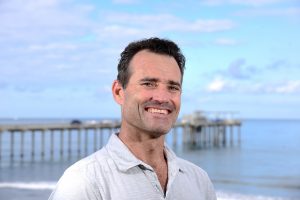
Dimitri Deheyn
Please tell us briefly about your work and your goals.
I am a marine biologist at Scripps Institution of Oceanography where I lead a laboratory focusing research on biomimicry: What can we learn from nature to optimize bioengineering and biotechnology. The overall goal of this work is to provide sustainable and “green” alternatives to current technology. This encompasses new light or color producing bioreporters, novel dyes for food or fabric use, and innovative biomaterials that integrate multiple functions. My work is fundamentally cross-disciplinary and involves chemists, engineers and material scientists. Overall, looking at nature for inspiration is based on the fact that organisms have evolved for billions of years and have adapted compounds, molecules and materials to a wide diversity of uses and functions that could be of societal benefits. Describing them and mimicking them can help us live in better integration with nature.
Did you make any interesting connections at BGN100?
BGN100 was a great event where I made multiple new connections, and some of them I have maintained as friends and colleagues. Aside from the connections, having “tapped” into the BGN100 network has also been important to me and my work. Indeed, after the event I met people from different professional networks who had also attended BGN100, and the common reference created an instant bond.
Are there other ways you have successfully connected with like-minded members of the community to further your mission?
Aside from BGN100, I am also a member of The Explorers Club, which has a similar mission of bringing together people from across disciplines with the same interests to push the boundaries. In this case, to push the boundaries of science and discovery with a deeper focus on scientific exploration.
When you’re not working, what do you enjoy doing?
I enjoy being active in nature, especially when coupled with travel and cultural experiences, alone or with friends, and with people (and kids) who otherwise have not had such experiences. I like hiking and rock climbing, mountaineering, ice climbing and snowboarding. I am a big fan of water sports of course, and like SCUBA diving and surfing. On a routine basis, I am a runner, and I play underwater hockey at a competitive level. Mens sana in corpore sano.
Do you have a favorite seafood story or recipe you’d like to share?
I like food in general and I especially like seafood when prepared by locals, with the spices and flavors native to where the seafood was collected. Squid ink pasta tastes so much better in Italy for some reason! I particularly like seafood when it is sustainably fished of course, but also when most, if not all, of the animal is used. I have had the opportunity to eat some great fish in Africa, where the fish was prepared so that the bones themselves were delicious to eat! An awesome dining experience!
Amro Hamdoun, Scripps Institution of Oceanography

Amro Hamdoun
Please tell us briefly about your work and your goals.
I am a research scientist and the focus of my laboratory’s work is to understand the biological mechanisms that determine how chemicals get into cells. These mechanisms are important for governing how cells talk to each other, and for deciding which foreign chemicals get into our bodies. We seek to accomplish two goals by studying these pathways – to discover entirely new biological pathways that could be important for understanding how living things work, and to change the way we manage and use environmental chemicals.
Did you make any interesting connections at BGN100?
Our recent work has focused on pollution in seafood, and BGN100 was chance for me to meet with many of the people in the local seafood community. It was interesting to discuss with them how we can accomplish the shared goals of ensuring people have access to safe, clean food from the sea. I also met with Congressman Scott Peters, and it was great to get some perspective on how water quality issues are being handled in the current climate.
Are there other ways you have successfully connected with like-minded members of the community to further your mission?
Years ago, I was a guest on a radio talk show to discuss pollution and I met a lot of people that way. I also meet a lot of very interesting and motivated people while teaching my class at UCSD. However, BGN100 was unique because there were so many relevant people all in the same place at the same time.
When you’re not working, what do you enjoy doing?
I like to swim in the ocean.
Do you have a favorite seafood story or recipe you’d like to share?
Probably the most interesting seafood recipe I’ve had is a grilled fish recipe used in some parts of the Mediterranean using fresh bream or mullet. The whole fish is coated with bran and put into a wood-fired stone oven. The skin gets totally blackened but peels away to reveal the inside of the fish – cooked absolutely perfectly. The fish are seasoned with nothing more than coarse salt and lemon juice.
Andrew Spurgin’s Pacific Salt-Crusted Fish with Ginger Scallion Sauce
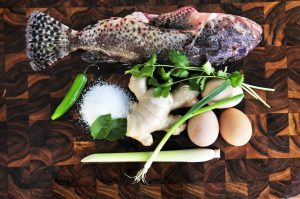
Photo credit: Dawn Horine
Serves three to four
- 3-4 lb. Whole fish such as yellowtail snapper, black grouper or white sea bass
- 1 Fresh kaffir lime, ¼” slices (replace with key lime if unavailable)
- 3 Kumquats, ¼” slices
- 4 Fresh kaffir lime leaves, slightly crushed
- 1 Stalk peeled lemongrass, ¼” slices, on bias
- 8 Sprigs cilantro
- 2 Garlic cloves, smashed
- 4 Egg whites, lightly beaten
- 1 ½ 3 lb. boxes, Kosher salt
- Water
- ½ Cup scallions, whites and green, thinly sliced
- ½ Cup fresh young ginger (different from typical ginger), very finely minced
- ½ Teaspoon citrus flavoved soy sauce (kinko ponzu shoyu)
- 1 Tablespoon grapeseed oil
- ½ Teaspoon sesame oil
- ½ Teaspoon fish sauce
- Sea salt, such as Maldon
- Find products at most Asian grocery stores
- Fish sauce Vietnamese nước mắm – Red Boat 40ºN, or online 50ºN (my favorite) or Viêt Hu’o’ng Three Crabs brand is a sound choice
Equipment
Large bowl, small bowl, spoon, cutting board, large roasting/sheet pan. aluminum foil, heavy kitchen knife, pastry brush, two fish spatulas, large serving platter
Directions
- Pre-heat the oven to 375ºf
- Scale, gut, de-gill and remove all fins from whole sustainable handlined white flaky fleshed fish
Preparation
- Line a sheet pan with aluminum foil (easier cleanup).
- Fill the belly and mouth cavity with kaffir lime, kaffir lime leaves, kumquats, lemongrass, four sprigs of cilantro and garlic
- In large bowl fold in egg whites with kosher salt, add water, mixture should be the consistency of a snowball. Too wet and salt will crack when baked, too dry and it won’t hold to fish
- Lay down approximately ¾” layer of kosher salt, place the fish on top. Cover the entire fish with the salt mixture, approximately ¾” thick; basically you’re making a salt oven
- Bake for approximately 35/40 minutes
- While fish is baking mix together scallions, young ginger, yuzu-soy sauce, sesame oil, grapeseed oil, fish sauce, sprinkle with sea salt, taste, adjust seasonings if needed
- Remove fish from oven, rest for several minutes, with a heavy kitchen knife, lightly tap around the bottom edge of the salt crust (near the sheet pan) until cracked all the way around the fish
- Carefully lift off the salt crust, it will easily pull away from the fish. Lightly brush off any remaining salt flakes from the fish with a pastry brush if necessary
- Slice just behind the head, slice the filet just before the tail. Carefully slice the fish lengthwise to split the top filets in half. Gently lift out the two filets, check for pin bones, place on a warmed serving platter
- Carefully pull out the backbone, from tail end, all, or most, of the other bones will come with it. Lift out the lower filets as you did with the upper ones
- Top with Maldon sea salt (if needed, taste). Serve the scallion-ginger mixture on the side, garnish with remaining cilantro sprigs and serve immediately.
Serving suggestion:
- Serve with simple cucumber salad with Thai basil, mint, bean shoots and shredded cabbage. Toss in a vinaigrette with rice wine vinegar, nước mắm, sugar and chilies. Flash fried wontons on the side
- Great with a dry Riesling wine or Champagne!
Alternative filling:
Parsley, thyme, basil, bay leaf, lemon and garlic. Serve with slowly roasted cherry tomatoes ON the vine. Roast tomatoes with sliced shallots, garlic, thyme sprig, sea salt, pepper and olive oil. Serve warm on the side with torn fresh opal and green basil. Squeeze lemon on fish and drizzle with good olive oil.
Andrew Spurgin™
Bespoke Event Styling & Menu Design
www.andrewspurgin.com
andrew@andrewspurgin.com
619.277.6020
